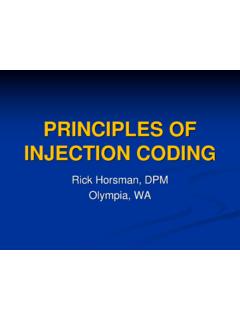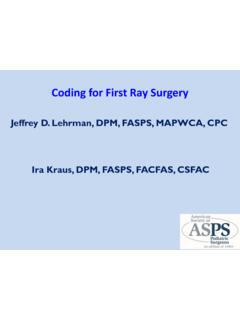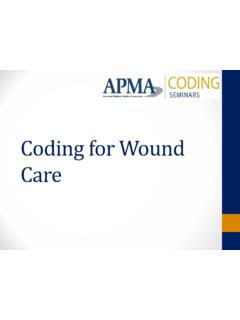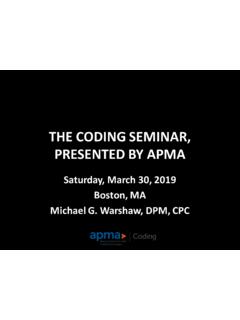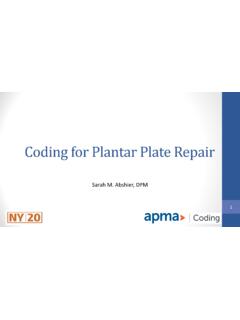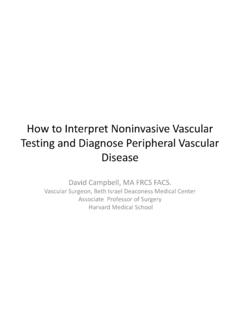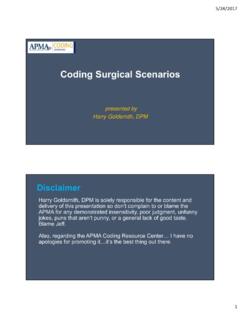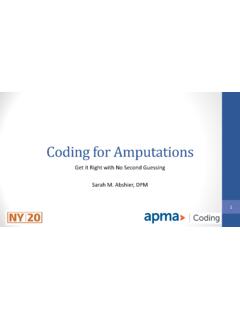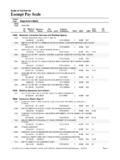Transcription of High Ankle Sprains: Diagnosis & Treatment
1 High Ankle Sprains: Diagnosis & TreatmentMark J. Mendeszoon, DPM, FACFAS, FACFAOMP recision Orthopaedic SpecialtiesUniversity Regional Hospitals Advanced Foot & Ankle Fellowship-DirectorIt Is Only an Ankle SprainEvaluate Degree of Ecchymosis & EdemaIf Not Properly TreatedChronic Pain & Ankle InstabilityEpidemiologyWaterman et al. JBJS 2010 states: 2 million Ankle sprains per year = 2 billion in health care cost Injury results in time lost and disability in 60% of patients 30% of all sport injuryEpidemiologySyndesmotic Injuries: 1% to 18% of all Ankle sprains 32% develop calcification and chronic pain High incidence of post traumatic arthritis Greater source of impairment than the typical lateral Ankle sprain AnatomyInferior Tibiofibular Joint: defined as a syndesmotic articulation which consists of five separate portionsMotion in all three planes Anatomy Syndesmotic Ligaments.
2 Anterior Inferior Tibio Fibular Ligament Posterior Inferior Tibio Fibular Ligament Transverse Tibio Fibular Ligament Interosseous Ligament Interosseous MembraneThe deep portion of the deltoid ligament also contributes to syndesmotic stabilityActing as a restraint against lateral shift of the talusDeltoid LigamentRELEVANT ASPECTS OFANKLE:A considerable clearance takes place between the talus and the distal fibula, which is limited by the tibiofibular syndesmosis With normal stance, almost no twisting and shearing forces act on the Ankle joint= static tibfib tension Axial loading tensions AITF and PITF with increase of 10 -17% of body weight intact syndesmosis, the intermalleolar distance increases with dorsiflexion of the talus by to mmBiomechanics of SyndesmosisHaraguchi et al.
3 2009 Intact syndesmosis Fibula ROTATES 2 * externallyEquals ~ mm mm Anterior -posteriorlyTHUS Fibula moves in 3 DOgilvie & Harris 1994 Study on Individual Ligaments for Syndesmotic Stability35% ATIFL33% TRANSVERSE IOL9% PTIFLMECHANISM OF INJURYHIGH VELOCITY INJURIESCOLLISION SPORTSSKIIINGX GAMESFORCED EXTERNAL ROTATIONSEVERE INVERSION & PLANTARFLEXIONCLASSIFICATIONACFAS 1997 EDWARDS & DELEE 1984 Gerber et al 1998 Perform Thorough History & PhysicalUnderlying Etiological Conditions ( Ligamentous Laxity)Understand Mechanism of InjuryEstablish Realistic Goals & Time TableInversion Ankle Sprain ExaminationProximal FibulaDistal FibulaPeroneal TendonsSinus Tarsi / Anterior Process CalcaneusCalcaneal -Cuboid JointBase of Fifth MetatarsalDeltoid LigamentsSQUEEZE TESTO ther Clinical Testing For High Ankle SprainsDorsiflexion Compression Dorsiflexion External RotationCrossed Leg TestHeel Thump Radiographic Exam3 views.
4 AP, Mortise, LateralContralateral X-RaysTibiofibular Clear SpaceMedial Clear SpaceTibiofibular OverlapExternal Rotational Stress TestAs static radiograph or intra operatively Shows widening of tib-fib clear space and can show deltoid disruptionRadiographic ExamAssociated InjuriesAnkle Fractures: PER 3, SER 4, PABM aisonneuvePosterior Malleolar FracturesTillaux Chaput FracturesAssociated Injuries TestingCT ScanAccurateDetect Diastasis of 2-3 mmBilateral observes: fibular shift, rotation, shortening avulsionsDiagnostic UltrasoundPerform in OfficeQuick & InexpensiveNo RadiationLearning Curve**Mei-Dan et al Sports Med 201189% specificity/sensitivity AITFL mmGold StandardShown to effectively display the components of the syndesmotic complex with high interobserver agreement93% specificity and 100%sensitivity for injury of the AITFL, and 100% specificity and sensitivity for injury ofthe PITFL compared with arthroscopy in acute injuriesMRID irect visualization of AITFL and PITFL Must use both anterior and posterior portals Intraoperative Dx User dependent.
5 Learning curve Can perform complete direct repair Diagnostic ArthroscopyTreatment ProtocolConservative TreatmentRICENSAIDSNWB BootPhysical TherapyFavorable results:86 -100% Good to Excellent OutcomesSurgical IndicationsDiastasis > 2mm isolated or with Fractures REQUIRES SURGERYS urgical AlgorithmPercutaneous repair: Single or double screws with or w/out plate or washers Absorbable screws Suture button (single or double)Direct repair: Arthroscopic debridement with direct ligament repair Open with tendon graft Surgical TreatmentApproach: Anterolateral linear over distal fibulaAllows complete debridementof avulsed ligaments tissue or debris that may block proper reductionSurgical TreatmentReduction.
6 Position the fibula properly into the incisura fibularisof the tibia, which is best achieved with a bimalleolar (pelvic) reduction clampThe anteriorrim of the fibula should align with Chaput s tuberculeSurgical TreatmentIn cases of malreduction the medial aspect ofthe Ankle and the deltoid ligament should be explored via arthrotomy All ligamentous or capsular debris is removedAfter proper reduction,the position of the fibula may be secured temporarily with a Kirschner wireEnsure that a proper tibiofibular distance is obtained in Neutral Ankle PositionSurgical TreatmentPearls for Screw Placementscrews applied 30 degrees posterolateral-anteromedialscrews placed 2 cm cm above joint lineobtain minimum 3-4 corticesFull Threaded ScrewsWashers vs.
7 PlatesOutcomes of screw Treatment :Leeds and Ehrlich + Fritschy no recurrence after open reduction, screw fixation, and suture of the AITFLE dwards and DeLee 4-year results of 34 patients = adequacy of syndesmosis reduction and arthritis at followup Proper syndesmosis reduction is key Suture button:Follows same principles as screw fixationFaster rehabilitation?1 vs. 2 Clinical studies show relatively equal rigidity as compared with screws Allows more normal motion of joint Surgical TreatmentOpen with Tendon Graft Well suited more for chronic diastasisSurgical TreatmentPost Operative Carescrews removed 10 -12 weeksNWB 2-4 weeks castWB as tolerated 4-6 weeksPhysical Therapy after screws removedPost Op ComplicationsTypical Post Op ComplicationsHeterotopic Ossifications ~ 32%Tib-Fib Synostosis with persistent painCHRONIC INSTABILTY DUE TO MISSED Diagnosis OR MALREDUCTIONR eviewSyndesmotic Complex provides a dynamic support to the Ankle for normal motionUnderstanding Anatomy.
8 Biomechanics & Mechanism of Injury is ParamountAppreciated Clinical Exam & Special TestingRecognize Diagnostic TestingAppreciate Surgical Indications & Techniques

